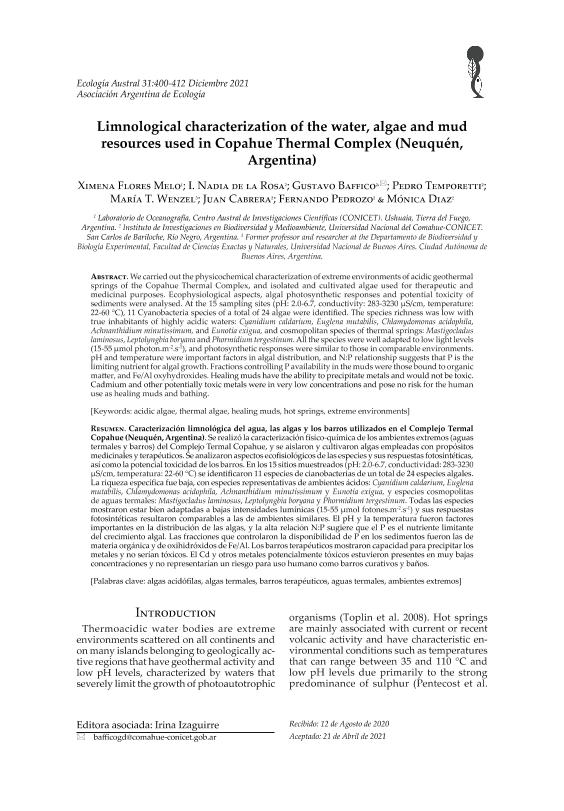Artículo
We carried out the physicochemical characterization of extreme environments of acidic geothermal springs of the Copahue Thermal Complex, and isolated and cultivated algae used for therapeutic and medicinal purposes. Ecophysiological aspects, algal photosynthetic responses and potential toxicity of sediments were analysed. At the 15 sampling sites (pH: 2.0-6.7, conductivity: 283-3230 µS/cm, temperature: 22-60°C), 11 Cyanobacteria species of a total of 24 algae were identified. The species richness was low with true inhabitants of highly acidic waters: Cyanidium caldarium, Euglena mutabilis, Chlamydomonas acidophila, Achnanthidium minutissimum, and Eunotia exigua, and cosmopolitan species of thermal springs: Mastigocladus laminosus, Leptolyngbia boryana and Phormidium tergestinum. All the species were well adapted to low light levels (15-55 µmol photon.m-2.s-1), and photosynthetic responses were similar to those in comparable environments. pH and temperature were important factors in algal distribution, and N:P relationship suggests that P is the limiting nutrient for algal growth. Fractions controlling P availability in the muds were those bound to organic matter, and Fe/Al oxyhydroxides. Healing muds have the ability to precipitate metals and would not be toxic. Cadmium and other potentially toxic metals were in very low concentrations and pose no risk for the human use as healing muds and bathing. Se realizó la caracterización físico-química de los ambientes extremos (aguas termales y barros) del Complejo Termal Copahue, y se aislaron y cultivaron algas empleadas con propósitos medicinales y terapéuticos. Se analizaron aspectos ecofisiológicos de las especies y sus respuestas fotosintéticas, así como la potencial toxicidad de los barros. En los 15 sitios muestreados (pH: 2.0-6.7, conductividad: 283-3230 µS/cm, temperatura: 22-60 °C) se identificaron 11 especies de cianobacterias de un total de 24 especies algales. La riqueza específica fue baja, con especies representativas de ambientes ácidos: Cyanidium caldarium, Euglena mutabilis, Chlamydomonas acidophila, Achnanthidium minutissimum y Eunotia exigua, y especies cosmopolitas de aguas termales: Mastigocladus laminosus, Leptolyngbia boryana y Phormidium tergestinum. Todas las especies mostraron estar bien adaptadas a bajas intensidades lumínicas (15-55 µmol fotones.m-2.s-1) y sus respuestas fotosintéticas resultaron comparables a las de ambientes similares. El pH y la temperatura fueron factores importantes en la distribución de las algas, y la alta relación N:P sugiere que el P es el nutriente limitante del crecimiento algal. Las fracciones que controlaron la disponibilidad de P en los sedimentos fueron las de materia orgánica y de oxihidróxidos de Fe/Al. Los barros terapéuticos mostraron capacidad para precipitar los metales y no serían tóxicos. El Cd y otros metales potencialmente tóxicos estuvieron presentes en muy bajas concentraciones y no representarían un riesgo para uso humano como barros curativos y baños.
Limnological characterization of the water, algae and mud resources used in Copahue Thermal Complex (Neuquén, Argentina)
Título:
Caracterización limnológica del agua, las algas y los barros utilizados en el Complejo Termal Copahue (Neuquén, Argentina)
Flores Melo, Elizabeth Ximena ; de la Rosa, Iris Nadia
; de la Rosa, Iris Nadia ; Baffico, Gustavo Daniel
; Baffico, Gustavo Daniel ; Temporetti, Pedro Felix
; Temporetti, Pedro Felix ; Wenzel, María T.; Cabrera, Juan Manuel
; Wenzel, María T.; Cabrera, Juan Manuel ; Pedrozo, Fernando Luis
; Pedrozo, Fernando Luis ; Diaz, Monica Mabel
; Diaz, Monica Mabel
 ; de la Rosa, Iris Nadia
; de la Rosa, Iris Nadia ; Baffico, Gustavo Daniel
; Baffico, Gustavo Daniel ; Temporetti, Pedro Felix
; Temporetti, Pedro Felix ; Wenzel, María T.; Cabrera, Juan Manuel
; Wenzel, María T.; Cabrera, Juan Manuel ; Pedrozo, Fernando Luis
; Pedrozo, Fernando Luis ; Diaz, Monica Mabel
; Diaz, Monica Mabel
Fecha de publicación:
12/2021
Editorial:
Asociación Argentina de Ecología
Revista:
Ecología Austral
ISSN:
0327-5477
e-ISSN:
1667-782X
Idioma:
Inglés
Tipo de recurso:
Artículo publicado
Clasificación temática:
Resumen
Palabras clave:
ACIDIC ALGAE
,
THERMAL ALGAE
,
HEALING MUDS
,
HOT SPRINGS
,
EXTREME ENVIRONMENTS
Archivos asociados
Licencia
Identificadores
Colecciones
Articulos(CADIC)
Articulos de CENTRO AUSTRAL DE INVESTIGACIONES CIENTIFICAS
Articulos de CENTRO AUSTRAL DE INVESTIGACIONES CIENTIFICAS
Articulos(INIBIOMA)
Articulos de INST. DE INVEST.EN BIODIVERSIDAD Y MEDIOAMBIENTE
Articulos de INST. DE INVEST.EN BIODIVERSIDAD Y MEDIOAMBIENTE
Citación
Flores Melo, Elizabeth Ximena; de la Rosa, Iris Nadia; Baffico, Gustavo Daniel; Temporetti, Pedro Felix; Wenzel, María T.; et al.; Limnological characterization of the water, algae and mud resources used in Copahue Thermal Complex (Neuquén, Argentina); Asociación Argentina de Ecología; Ecología Austral; 31; 3; 12-2021; 400-412
Compartir
Altmétricas



